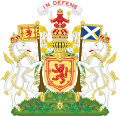The word derives from late Latin bandum, a cloth out of which a flag is made (Latin banderia, Italian bandiera), (Spanish bandera). German developed the word to mean an official edict or proclamation and since such written orders often prohibited some form of human activity, bandum assumed the meaning of a ban, control, interdict or excommunication. Banns has the same origin meaning an official proclamation, and abandon means to change loyalty or disobey orders, semantically "to leave the cloth or flag".
Contents[hide] |
[edit] Heraldic banners
Further information: Heraldic flag
A heraldic banner, also called banner of arms, displays the basic coat of arms only: i.e. it contains the design usually displayed on the shield and omits the crest, helmet or coronet, mantling, supporters, motto or any other elements associated with the coat of arms (for further details of these elements, see heraldry).A heraldic banner is usually square or rectangular.
A distinction exists between the heraldic banner and the heraldic standard. The distinction, however, is often misunderstood or ignored. For example the Royal Standard of the United Kingdom is in fact a banner of the royal arms.
-
-
- The heraldic banner of the King of Scots; the Royal Standard of Scotland, depicting the principal charge of the arms.
- Heraldic banner of Cardinal Wolsey.
[edit] Banners in a religious context
The prophet Isaiah was commanded to raise a banner and exalt his voice (Isaiah 13:2 KJV). Habakkuk received a similar order to write a vision upon tables that could be read by one who runs past it (Habakkuk 2:2).In Christianity
For more on the design and making of church banners, see Banner-making. For banners used in the Eastern Orthodox Church, see Khorugv.
Banners in churches have, in the past, been used mainly for processions, both inside and outside of the church building. However, the emphasis has, in recent years, shifted markedly towards the permanent or transient display of banners on walls or pillars of churches and other places of worship. A famous example of large banners on display is Liverpool R.C. Cathedral, where the banners are designed by a resident artist.Banners are also used to communicate the testimony of Jesus Christ by evangelists and public ministers engaged in Open Air Preaching.
Trade union banners
In Britain, trade union banners have been made since the 1840s, and at May Day parades, they could be counted in the hundreds. The iconography of these banners included mines, mills, factories, but also visions of the future, showing a land where children and adults were well-fed and living in tidy brick-built houses, where the old and sick were cared for, where the burden of work was lessened by new technology, and where leisure time was increasing. The same kind of banners are also used in many other countries. Many, but not all of them, have red as a dominant colour.For more on the design and making of these banners, see Banner-making.
[edit] Advertising banners: pre-printed banners and custom banners

2009 Michigan Wolverines football team enters Michigan Stadium under the M Club banner as the Michigan Marching Band salutes.

Banner at Wikimania 2005.
Banners are used in many business ventures, marketing to their potential audience. A number of British towns and cities have whole series of banners decorating their city centres, effectively advertising the town or its special features and attractions. Pre-printed banners, albeit commonly used, are simple and accessible. Banners can be printed in enormous formats, with a full range of rich colors.
Banners can be found plastered behind a window screen, as billboards, atop skyscrapers, or towed by airplanes or blimps. As with variable of size and quantity, the number of sides and quality of ink are as much of a crucial factor. In an instance of retail stores which purchase pre-printed clearance banners, or a variety of sale banner. A banner facing underneath or against glass is absorbing exposure from the sun. A banner printed on UV outdoor ink will last several years to a decade where cheaper ink fades, requiring frequent replacement.[2] Being behind glass, a two-sided banner can be displayed from the inside and out, often building recognition between shoppers and caretakers. Three-sided banners are oftentimes appealing as there is dimension and can be embellished differently. The more sides that exist, the more angles the banner covers, which is a possibility where a two-sided banner doesn't face the viewer from center of the room or streets.






Tidak ada komentar:
Posting Komentar